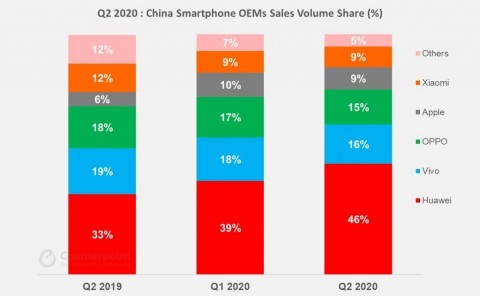One in Three Smartphones Sold in China in Q2 2020 Was a 5G Phone
One in Three Smartphones Sold in China in Q2 2020 Was a 5G Phone
Huawei captured a massive 60% share of the 5G smartphone market
SEOUL & HONG KONG & NEW DELHI & BEIJING & LONDON & BUENOS AIRES & SAN DIEGO--(BUSINESS WIRE)--Smartphone sales in China declined 17% YoY in Q2 2020, according to Counterpoint’s Market Pulse, a monthly smartphone sales tracking service. However, the sales increased 9% QoQ, indicating some signs of recovery. COVID-19 has been mostly contained in China, but the demand for smartphones is yet to recover to pre-COVID levels.
Commenting on the overall Chinese smartphone market growth, Counterpoint Research Analyst Mengmeng Zhang said: “Although China’s commercial activities have resumed, consumer confidence remains low. Both OEMs and Chinese operators are actively pushing 5G smartphones by lowering prices of 5G devices as well as 5G plans. This has increased the adoption of 5G, with one-third of the total smartphone sales during the quarter being 5G devices, the highest adoption in the world.”
Highlighting the fiercely competitive landscape, Counterpoint Research Analyst Flora Tang said, “Huawei continues to be the best performer in the China market, grabbing 46% market share in the quarter. Huawei achieved 14% YoY growth despite the overall market slowdown. China has become the most important market for Huawei as its overseas shipments saw a sharp decline after it lost the ability to use GMS in its latest smartphones. Apple was the fastest-growing key OEM during the quarter. Despite the market decline, Apple grew an impressive 32% YoY due to the continued popularity of the iPhone 11 series and price cuts. June was the best month in terms of smartphone sales so far this year after the COVID-19 outbreak, driven by surge in sales of Xiaomi (+42% MoM) and Huawei (+11%).”
Counterpoint Senior Analyst Ethan Qi said: “Despite a slowdown in China’s smartphone market, Chinese OEMs have picked up pace in 5G. In Q2, 33% of the smartphones sold were 5G-enabled compared to just 16% in Q1. The proportion was even higher in June, at more than 40%. China’s 5G smartphone market is quite consolidated with HOVX grabbing 96% of the market. Huawei accounts for 60% of the market here.”
The detailed version of the press release can be found here.
Visit our Data Section to get the latest smartphone market share for China and other countries.
Contacts
Mengmeng Zhang
mengmeng@counterpointresearch.com
Flora Tang
flora@counterpointresearch.com
Ethan Qi
ethan@counterpointresearch.com
Tarun Pathak
tarun@counterpointresearch.com

